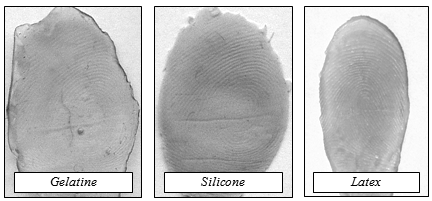|

Home

People

Research

Publications

Resources

Related Links
|
|
Fake Finger DetectionAs any other authentication technique, fingerprint recognition is not totally spoof-proof. The main potential threats for fingerprint-based systems are: - attacking the communication channels, including replay attacks on the channel between the sensor and the rest of the system;
- attacking specific software modules (e.g. replacing the feature extractor or the matcher with a Trojan horse);
- attacking the database of enrolled templates;
- presenting fake fingers to the sensor.
The feasibility of the last type of attack has been reported by some researchers: they showed that it is actually possible to spoof some fingerprint recognition systems with well-made fake fingertips, created with the collaboration of the fingerprint owner or from a latent fingerprint: in the latter case the procedure is more difficult but still possible. 
In 2005, BioLab developed two novel approaches for fake finger detection: - Fake finger detection based on the analysis of skin distortion. The user is required to move his finger while pressing it against the scanner surface, thus deliberately exaggerating the skin distortion. When a real finger moves on a scanner surface, it produces a significant amount of distortion, which can be observed to be quite different from that produced by fake fingers. Usually fake fingers are more rigid than skin, then the distortion is definitely lower; even if highly elastic materials are used, it seems very difficult to precisely emulate the specific way a real finger is distorted, because the behavior is related to the way the external skin is anchored to the underlying derma and influenced by the position and shape of the finger bone.
- Fake finger detection based on odor analysis. Electronic noses are used with the aim of detecting the odor of those materials that are typically used to create fake fingers (e.g. silicone or gelatin).
 View a demo of the skin-distortion-based fake detection approach View a demo of the skin-distortion-based fake detection approach
 View a demo of the odor-based fake detection approach View a demo of the odor-based fake detection approach
Bibliography(Click here if you are interested in any of the publications below) | D. Maltoni, D. Maio, A.K. Jain and J. Feng, Handbook of Fingerprint Recognition (Third Edition), Springer Nature, 2022. |  | J. Galbally, J. Fierrez-Aguilar and R. Cappelli, "An Introduction to Fingerprint Presentation Attack Detection", in Marcel, Sébastien, Nixon, Mark S., Li, Stan Z. (Eds), Handbook of Biometric Anti-Spoofing, Springer, 2019.  Abstract Abstract |  | J. Galbally, J. Fierrez-Aguilar, J. Ortega-Garcia and R. Cappelli, "Fingerprint Anti-spoofing in Biometric Systems", in Marcel, Sébastien, Nixon, Mark S., Li, Stan Z. (Eds), Handbook of Biometric Anti-Spoofing, Springer, 2014.  Abstract Abstract |  | A. Franco and D. Maltoni, "Fingerprint Synthesis and Spoof Detection", in N.K. Ratha, V. Govindaraju, Advances in Biometrics: Sensors, Algorithms and Systems, Springer, 2008.  Abstract Abstract |  | M. Ferrara, R. Cappelli and D. Maltoni, "Detecting Double-Identity Fingerprint Attacks", IEEE Transactions on Biometrics, Behavior, and Identity Science, vol.5, no.4, pp.476-485, October 2023.  Abstract Abstract |  | J. Galbally, R. Cappelli, A. Lumini, G. Gonzalez-de-Rivera, D. Maltoni, J. Fierrez-Aguilar, J. Ortega-Garcia and D. Maio, "An Evaluation of Direct Attacks Using Fake Fingers Generated from ISO Templates", Pattern Recognition Letters, vol.31, no.8, pp.725-732, June 2010. Award winning papers from the 19th International Conference on Pattern Recognition (ICPR), 19th International Conference in Pattern Recognition (ICPR).  Abstract Abstract |  | D. Maltoni and R. Cappelli, "Advances in fingerprint modeling", Image and Vision Computing, vol.27, no.3, pp.258-268, February 2009.  Abstract Abstract |  | A. Antonelli, R. Cappelli, D. Maio and D. Maltoni, "Fake Finger Detection by Skin Distortion Analysis", IEEE Transactions on Information Forensics and Security, vol.1, no.3, pp.360-373, September 2006.  Abstract Abstract |  | R. Cappelli, A. Franco, D. Maio and D. Maltoni, "Guardie e ladri nell'era biometrica", Darwin, no.13, pp.48-53, May 2006.  |  | A. Antonelli, R. Cappelli, D. Maio and D. Maltoni, "Apparecchio e metodo per discriminare una impronta digitale vera da una impronta digitale artificiale falsa, attraverso l’analisi della distorsione elastica della pelle", Patent N. BO2005A000399, 2005.   Abstract Abstract |  | D. Baldisserra, A. Franco, D. Maio and D. Maltoni, "Apparecchio e metodo per discriminare una impronta digitale vera da una impronta digitale artificiale attraverso l’analisi dell’odore del dito associato all’impronta digitale da discriminare", Patent N. BO2005A000398, 2005.   Abstract Abstract |  | D. Baldisserra, A. Franco, D. Maio and D. Maltoni, "Fake Fingerprint Detection by Odor Analysis", in proceedings International Conference on Biometric Authentication (ICBA06), Hong Kong, January 2006.  Abstract Abstract |  | A. Antonelli, R. Cappelli, D. Maio and D. Maltoni, "A new approach to fake finger detection based on skin distortion", in proceedings International Conference on Biometric Authentication (ICBA06), Hong Kong, January 2006.  Abstract Abstract |
|


